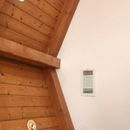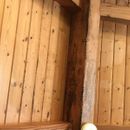Moisture on open beam ceiling
Hello,
I read some of the other questions and answers concerning moisture or perhaps condensation on the underside of the ridge beam in an open beam ceiling. Some of what others have experienced sounds similar, yet different too.
we just bought the house and could see there was evidence of previous water on the ceiling and end wall (toward exterior). We thought this was coming in from the outside. This room was an addition to the house. is a room about 14 x 18 feet running north to south, so east and west facing roof slopes. The south end abuts the attic of the rest of the house. There is a heating vent high up on the wall. (see image). We have not used the heating some nights but not the cooling at all.
The north wall is to the exterior (see image). there are dark stains down the drywall under the ridge beam on this wall. There are also black marks , dots, on the beam and on the T&G. (see image).
I am not sure exactly how this was constructed, but the actual roof system is 2×10 at 24″ with some insulation, plywood and asphalt shingles. no ridge vent. no eave openings. The T&G and the beams are all solid, authentic.
We are in southern California. For a couple months it has been raining and then dry, then some rain. No rain in last couple of days. We have not seen any moisture. Today is sunny and in the 70ies. At about 3:00 in the afternoon we actually experience dripping from the beam.
What can be causing this, and how to correct it? From the discoloring it has clearly been happening for some time.
Many thanks for any help you can provide. Michael808
GBA Detail Library
A collection of one thousand construction details organized by climate and house part












Replies
Solar heating can produce highly saturated warm air and this air rises to the peak where, with less solar heating in that area, it quickly cools. You can fix (or verify the cause) by keeping a fan blowing at the peak area. It will dilute the water vapor. There are some GBA discussions of the issue.
Roof leaks are related to when it rains and dripping doesn't peak on sunny afternoons.
thank you very much Jon. I was so surprised by how much moisture there was. I will search previous GBA discussions.
M
Michael,
Here is a link to a relevant GBA article: "Summertime Condensation Near the Peak of a Cathedral Ceiling."
I just went back and reread Martin's article. I remain unconvinced that across the 6 case studies there are enough similar or identical conditions to generalize, particularly to conclude that in each case, including this one in this GBA Q&A is condensation-driven, particularly when it happens in mid-afternoon when it is sunny.
When we are attributing the condensation to hygric buoyancy, the pattern on the ceiling should be more uniform (particularly when in the current case that nearby forced air vent is not moving any air). When we see localized moisture evidence/damage, it's almost always an air leak or a bulk water leak. And it's hard to support warm moist interior air leaking into a cathedral roof assembly on a sunny 70F day condensing as it makes its way up through the roof assembly?
That leaves the initial source of the moisture a bulk water leak? Is the prevailing wind during rain events from the north?
Is there any way that you can take exterior photos of the peak and roof expanse?
This one requires more sleuthing I think...
Peter
Hello, and thank you all for the brilliant investigation.
I can add some details. one difference I believe from the other cases mentioned is, our 'open beam ceiling' is just that -- a ceiling. it is not the structural ridge beam, there is a 2x10 structure above the beams and T&G.
The first I wrote about, I'll call Room 1. It was constructed around 2003-5.
There is also another similar roof in the house. call it Loft Room. In this case, the room is large, about 14x18 and is high enough to have a loft that has about 6-8 clearance. this roof has a 'short' side, just over the loft portion of room, sloping south, and a longer slope facing north. Under the loft are 2 bathrooms.
On the north side, high up, but not completely to the ridge, in the center of the roof, the plywood is completely dry rotted out so that visibly you can see the asphalt tiles dip. oddly there doesn't seem so be any water coming through the T&G ceiling. the south facing side seems strong, no rot.
In Loft Room, my thought was that the warm moist air was going up, and condensing I guess on the underside of the plywood, and with no circulation through this 2x10 bay space, the plywood rotted. so I thought a ridge vent and eave openings, replacing the plywood and all would do it.
then it started 'raining' in Room 1. in Room 1 there is water on the ceiling but the roof ply seems strong.
2 rooms, same construction, similar size, different orientation, potentially different amounts of moisture in the space ... I'm thinking showers for years without the exhaust fan adding to the moist in Loft Room.
Maybe the two roof sections need to be rebuilt without 'open beam ceiling'. see attached -- facade with LoftRoom,interior LoftRoom .
thanks for all thoughts.
M
My guess as to what is happening here.
During the night, especially clear nights the roof gets cold enough that the air leaks from the house condense on the roof sheathing. Over time time moisture slowly builds up in the sheathing.
During the day the heat from the sun causes this condenstion to evaporate and raise until it hits the colder surface of the ridge beam where it condenses, eventually dripping to the interior.
This also explains the sheathing damage in the loft area when you add in the extra moisture from the bathrooms.
If this is what is actually happening, some venting of the roof (ridge and soffit vents) would help as there would now be a way to move the moisture from the ceiling cavity during the day.
The better solution would be to add a couple of inches of rigid insulation during the next re-roofing.